How to preserve green peas for the winter: we protect the crop from spoilage in three different ways
Green peas are a versatile product that can be added to many dishes and consumed separately. In this article you will learn three main ways to preserve green peas for the winter so that they do not lose their taste and beneficial qualities.
Which peas are suitable for long-term storage?
Varieties of green peas are divided into three groups:
- Sugar. The name doesn't quite match the taste of the peas. It's actually not that sweet, it just lacks the tough layer of flesh. It becomes tasty only during the cooking process.
- Brain or peeling - the most common. These are already truly sweet peas, which are ideal for storing, canning and eating fresh.
- Feed. Used for cultivation on an industrial scale, the taste is very mediocre. Such varieties are not recommended for the garden - the costs of money and time are the same, but the result will not please you.

When and how to harvest peas correctly
In order for green peas to delight you with their taste all winter, you need to harvest them correctly. The main thing is to do it on time. The pods should be green, without spots or yellow mesh, and the peas should be fully ripe. If the pods are flat, the peas in them are still small and too tender to pick. If a mesh has already appeared on the pods, it means the peas are overripe, they are no longer so juicy and sweet. Withered pods indicate dried out peas.
Attention! Peas are harvested several times a season in dry, sunny weather. Excessive moisture will cause the pods to become damp and begin to rot.
Storing peas in pods and without
Peas can be stored and consumed in pods. Sugar varieties are suitable for this. In this case, it is not necessary to wait until the peas are fully ripe.
The pods are collected, placed in plastic bags and stored in the refrigerator for no more than 1 week. Then the peas will start to spoil. Its taste changes already on the second day of storage, because the sugar in the grains turns into starch.
Note! Drying, freezing and canning work equally well for peas and whole pods.
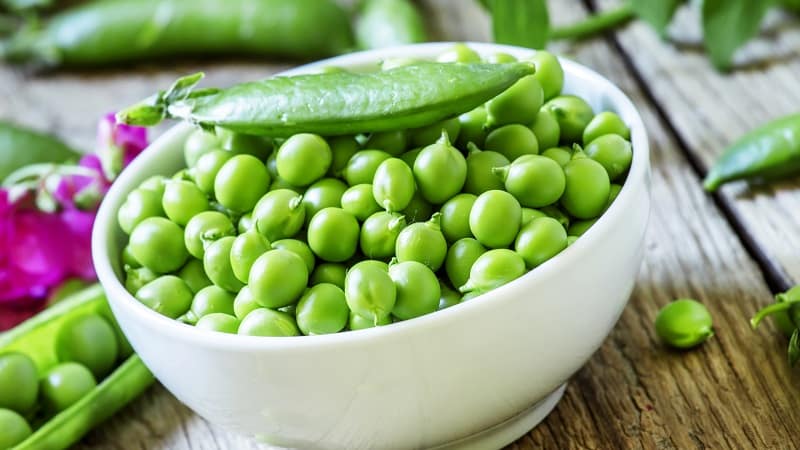
How to dry peas correctly
Before drying, peas undergo proper preparation:
- We rinse it under running water.
- Place in boiling water for 2 minutes.
- Place in a colander and place in cold water (to preserve fresh green color).
- Then place the peas in boiling water again for 1 minute.
- Remove and place on paper towels to dry.
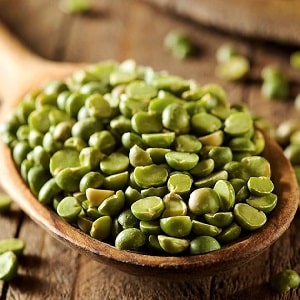 Drying peas at home in three ways:
Drying peas at home in three ways:
- Without the use of special heating. We use large areas to lay out the peas in one layer. The air must be dry and the room well ventilated, otherwise the fruits will rot.
- In the oven. Place the peas in a single layer on a baking tray lined with baking paper. Place in the oven, preheated to +45°C for 2-3 hours. Leave the door slightly open for air circulation.
- In an electric dryer. We install all the trays in it, regardless of the number of peas. We dry it for 6–8 hours at a temperature of +60°C. With this method, peas can be used raw, without blanching.
Determine the readiness of dried peas by appearance and touch. It becomes wrinkled and dark green in color. The surface is velvety to the touch; when compressed, there should be no air chambers inside. If the peas remain soft, it means they are not dried yet. But peas shouldn’t be hard as a rock either.
Proper freezing of peas
Freezing guarantees product freshness throughout the entire shelf life. You can freeze both grains and pods completely. Both must be intact, without defects. We choose grains that are mature, fleshy and tender. If you decide to freeze peas, start this procedure within 1-2 hours after assembly.
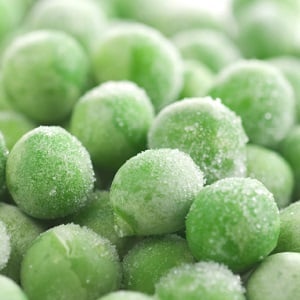 The stage of grain preparation is the same as during drying. Blanch (alternately dip the fruits in boiling water and cold water) as desired. Place the washed and dried peas on a tray or tray in one layer and place in the freezer.
The stage of grain preparation is the same as during drying. Blanch (alternately dip the fruits in boiling water and cold water) as desired. Place the washed and dried peas on a tray or tray in one layer and place in the freezer.
Since freezing is a quick process, you can freeze it in batches: while one is in the freezer, prepare the next one. To do this, you can use ice molds: distribute the peas, fill them with water and put them in the freezer.
Pea pods are frozen according to the same procedure.. Not quite ripe specimens are selected, washed, allowed to dry and sent for quick freezing. If desired, you can cut the pods in half and use them for preparing first courses without defrosting.
Canning green peas: the best recipes
The third common way to store peas is canning or pickling. It will take more time, but your own homemade canned green peas are an excellent alternative to store-bought ones. After all, you make it with your own hands and from proven ingredients.
For conservation choose large, dense, mature peas without damage. Preparation with this method is extremely simple.Peas are peeled from the pods and washed under running water.
The simplest canning recipe
Here the easiest way to preserve peasrequiring a minimum of ingredients:
- For 1 kg of peas, take 1 liter of water and 1 tbsp. l. salt.
- Place the washed peas in boiling water and cook for 3-5 minutes. Remove the resulting foam.
- Drain the water and rinse the peas in warm water. If you find bursting peas, remove them, otherwise the brine will become cloudy.
- Pour peas into sterilized 0.5 liter jars and fill with brine. Add ¼ tsp to each jar. 9% vinegar.
- Roll up the lids, turn the jars upside down and leave to cool. After this, we put the jars in the refrigerator or cellar for storage.

Preservation recipe with citric acid
If you don't want to use vinegar, there is a good way to replace it with citric acid. For 600 g of peas you will need 1 liter of water, 10 g of citric acid, 50 g of salt and sugar:
- Place a saucepan on the fire, pour in water, add salt and sugar to it. Bring to a boil, stirring constantly.
- Pour in the peas and wait for them to boil.
- Reducing the heat, cook for another 15–20 minutes, constantly shaking the pan. It is forbidden to stir peas, as this can crush the grains. Don't forget to remove any burst peas.
- At the end of cooking, add citric acid.
- Using a slotted spoon, place the peas in the jars (leaving about 1.5 cm to the top) and pour in the marinade from the same pan.
- We roll up the jars with sterile lids and turn them over to cool. You can cover it with a blanket.
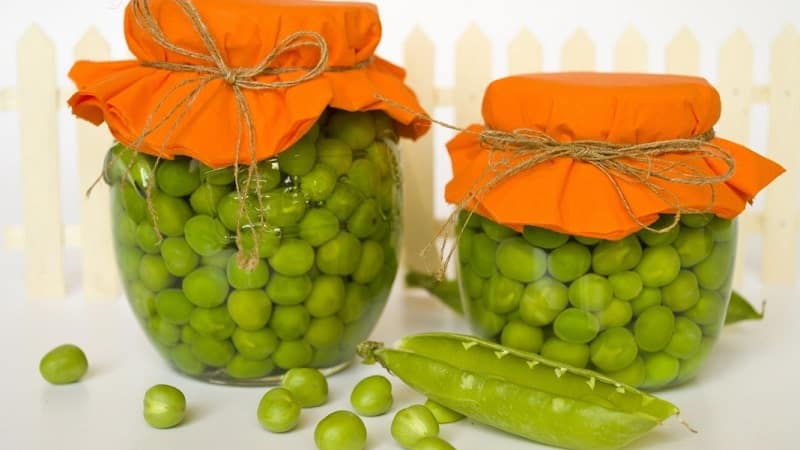
Recipe for canning whole pods
You can prepare unpeeled peas in this way. Wash them thoroughly under running water and thenLet's start marinating:
- Soak 0.5 kg of pea pods in cold water for 2 hours.
- Drain it and add boiling water for 2-3 minutes.
- Add 5 g of citric acid.
- Place the pods in prepared sterile jars (vertically). Add 5 tbsp. l. salt (for all jars). Add peppercorns and a cinnamon stick to taste.
- In a separate bowl, boil 5 tbsp. water, dissolve 3 tbsp in it. l. sugar and 400 ml of 3% acetic acid.
- Fill the jars with peas with the prepared brine and cover with lids.
- We send them to sterilize over low heat in boiling water for 20 minutes.
- Now you can roll up the jars, turn them over and cover them. Store in a cellar or refrigerator.
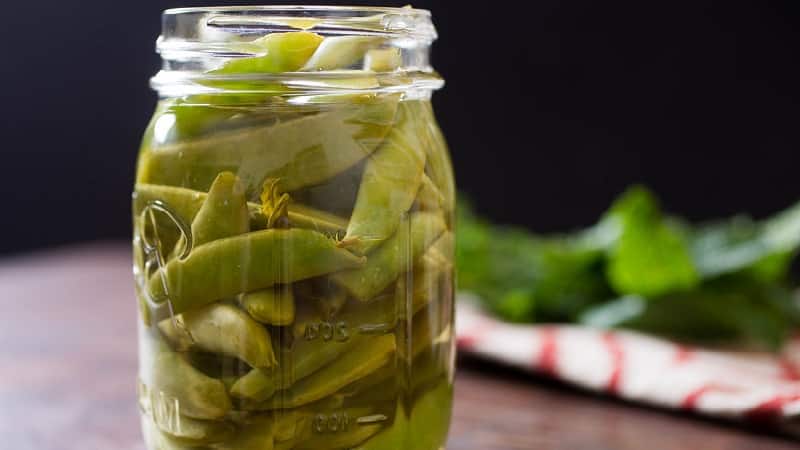
Storage conditions and periods
Dried peas can be stored for several years if the necessary conditions are met.:
- In a dry and dark place. Direct sunlight is not allowed.
- Room temperature - no higher than 25 °C. Do not store dry peas over the stove.
- The packaging must be sealed. Glass jars, plastic containers, and fabric bags are suitable. The main thing is to prevent insects from entering, otherwise the peas will have to be thrown away.
- It is advisable to use dried peas within 1 year.
Frozen peas will keep for 8 to 10 months if:
- storage temperature from –6 to –10°С;
- Immediately after freezing, the peas are poured into bags - it is better to divide them into small portions so as not to defrost in vain, since the beneficial qualities of the product will be lost.
Canned peas can be stored for up to 2 years if:
- jars are thoroughly sterilized before being sent to the refrigerator or basement;
- temperature - from +5 to +20°C, depending on the ingredients used - vinegar in the composition increases shelf life.
Useful tips
 Armed with our tips, you will know how to store peas longer and what to do in unexpected situations:
Armed with our tips, you will know how to store peas longer and what to do in unexpected situations:
- If you decide to dry peas, place a small bag of salt in the bottom of each jar or container. This will protect it from dampness and extend its shelf life.
- Check dry peas regularly (at least once a month) for insects. Do not rinse it; it is better to throw it away immediately, since fruits infected with insects are unsuitable for food.
- Distribute a small amount of peas among the bags in a single layer. Then arrange them with sheets of paper. This is necessary to prevent the peas from sticking together.
- If you find that the jars have begun to ferment, rinse the peas and transfer them to others, filling them with new brine.
Conclusion
Depending on your preferences, choose any type of green pea preparation for the winter. You will not only enjoy its taste for a long time, but will also delight your body with a portion of vitamins and beneficial microelements.